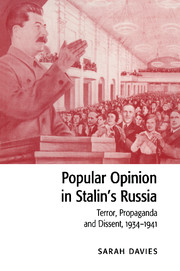Book contents
- Frontmatter
- Contents
- List of tables
- Acknowledgements
- Chronology
- List of abbreviations and archive references
- Glossary and notes on the text
- Introduction
- PART I ECONOMY AND SOCIETY
- PART II POLITICS AND TERROR
- 5 International relations
- 6 The Constitution and elections
- 7 The Great Terror
- 8 ‘Us’ and ‘them’: social identity and the terror
- PART III THE LEADER CULT
- Conclusion
- Notes
- Bibliography
- Index
8 - ‘Us’ and ‘them’: social identity and the terror
Published online by Cambridge University Press: 25 March 2010
- Frontmatter
- Contents
- List of tables
- Acknowledgements
- Chronology
- List of abbreviations and archive references
- Glossary and notes on the text
- Introduction
- PART I ECONOMY AND SOCIETY
- PART II POLITICS AND TERROR
- 5 International relations
- 6 The Constitution and elections
- 7 The Great Terror
- 8 ‘Us’ and ‘them’: social identity and the terror
- PART III THE LEADER CULT
- Conclusion
- Notes
- Bibliography
- Index
Summary
One theme in popular opinion emerges prominently in many of the previous chapters: a strong sense of social cleavage, of ‘us’ against ‘them’. This chapter will focus specifically on this theme, exploring its various modes of articulation, and suggesting how it may have resonated with official discourse on the terror.
According to Stalin, by the mid-1930s the Soviet Union had evolved into a socialist society without private property or antagonistic classes, in which a united Soviet people (edinyi sovetskii narod) of workers, peasants, and intelligentsia shared common interests. Since then, much energy has been expended on debates over whether the USSR could be considered a class society in the Marxist sense. This theoretical question will not be addressed directly here. Instead the focus will be upon the subjective perceptions of ordinary workers and peasants, and, in particular, on the language they employed to construct representations of their social identity.
The chapter will consider only identities articulated as ‘us against them’ in the sense of the ‘people’ (in various guises) against those perceived as powerholders. This conflictual, dichotomous image of society was in stark contrast to the static, hierarchical image propagated by the regime. It coexisted and competed with many other cleavages including those between new and cadre workers, between male and female workers, and between workers and peasants. However, such divisions were not incompatible with broader solidarities based on identification with ‘the people’ against ‘them’, the powerholders. Simply, different identities were articulated on different occasions and for different purposes.
- Type
- Chapter
- Information
- Popular Opinion in Stalin's RussiaTerror, Propaganda and Dissent, 1934–1941, pp. 124 - 144Publisher: Cambridge University PressPrint publication year: 1997
- 1
- Cited by



